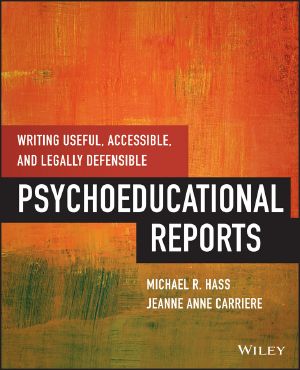Writing Useful, Accessible, and Legally Defensible Psychoeducational Reports

- Authors
- Hass, Michael, Carriere, Jeanne Anne & Carriere, Jeanne Anne M.
- Publisher
- Wiley
- Date
- 2014-03-24T00:00:00+00:00
- Size
- 1.05 MB
- Lang
- en
"This book focuses on how to write a psychological reportthat is first and foremost helpful to consumers, while also beingtechnically and legally defensible. Like the reports the authorsdescribe, the book is carefully organized, beautifully written, andaccessible to practitioners as well as graduate students. It is abrilliant accomplishment that should be required reading for everyschool psychologist."
**--Brent Duncan, PhD, ** Professor of Psychology, Humboldt State University, Arcata CA
**PRACTICAL GUIDANCE ON WRITING USEFUL, ACCESSIBLE, AND LEGALLYDEFENSIBLE PSYCHOEDUCATIONAL REPORTS**
From clearly identifying reasons for referral to makingrecommendations based on assessment results, *Writing Useful, Accessible, and Legally Defensible Psychoeducational Reports*offers practical guidance for creating reports that enhance theunderstanding of children and their strengths and challenges inorder to better meet their educational and functional needs.
The authors offer step-by-step guidelines for developing anassessment plan in a collaborative process with parents, teachers, and other professionals, choosing appropriate assessment and datacollection tools, gathering relevant information, and providingclear and feasible individualized recommendations that directlyrespond to referral concerns in a format easily understood byparents and teachers.
Ideal for graduate students in school psychology, schoolpsychologists, and other professionals in related fields who workwith children in a school setting, *Writing Useful, Accessible, and Legally Defensible Psychoeducational Reports: *
Provides specific suggestions for increasing the usefulness andaccessibility of reports including readability, positive phrasing, and vocabulary
Illustrates how to develop well-formed questions and how tochoose assessment tools to answer referral questions
Reviews the legal mandates of report writing and discusses whatmust be included
Demonstrates how to accurately document and integrate data fromrecord review, interviews, observations, and tests
Discusses how the use of the referral-based consultativeassessment and report writing model can promote more activeinvolvement in collaboration, prevention, and intervention
Features numerous real-world cases, helpful checklists, examples of question-driven referral reports, and a model interviewprotocol